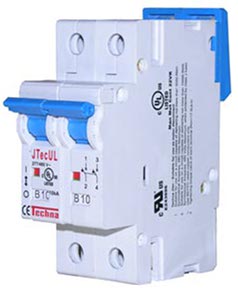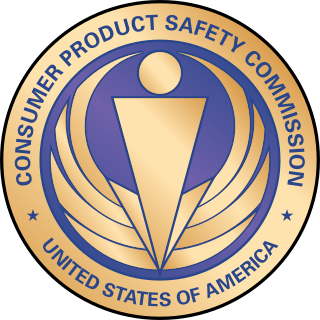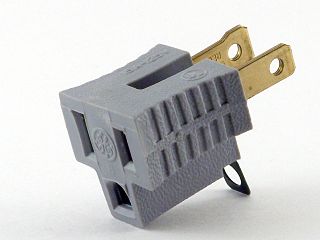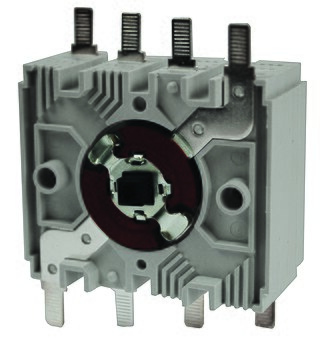
A circuit breaker is an electrical safety device designed to protect an electrical circuit from damage caused by overcurrent. Its basic function is to interrupt current flow to protect equipment and to prevent the risk of fire. Unlike a fuse, which operates once and then must be replaced, a circuit breaker can be reset to resume normal operation.

The UL enterprise is a global safety science company headquartered in Northbrook, Illinois, composed of three organizations, UL Research Institutes, UL Standards & Engagement and UL Solutions.

A surge protector (or spike suppressor, surge suppressor, surge diverter, surge protection device or transient voltage surge suppressor is an appliance or device intended to protect electrical devices in alternating current circuits from voltage spikes, which can arise from a variety of causes including lightning strikes in the vicinity and have a very short duration measured in microseconds.

A residual-current device (RCD), residual-current circuit breaker (RCCB) or ground fault circuit interrupter (GFCI) is an electrical safety device that interrupts an electrical circuit when the current passing through a conductor is not equal and opposite in both directions, therefore indicating an improper flow of current such as leakage current to ground or current flowing to another powered conductor. The device's purpose is to reduce the severity of injury caused by an electric shock. Injury from shock is limited to the time before the electrical circuit is interrupted, but the victim may also sustain further injury, e.g. by falling after receiving a shock. This type of circuit interrupter can not distinguish between current flowing though power carrying conductors that passes through a person from current that passes through electrical equipment and offer no protection when a person touches both conductors at the same time.

The National Electrical Code (NEC), or NFPA 70, is a regionally adoptable standard for the safe installation of electrical wiring and equipment in the United States. It is part of the National Fire Code series published by the National Fire Protection Association (NFPA), a private trade association. Despite the use of the term "national," it is not a federal law. It is typically adopted by states and municipalities in an effort to standardize their enforcement of safe electrical practices. In some cases, the NEC is amended, altered and may even be rejected in lieu of regional regulations as voted on by local governing bodies.

In electronics and electrical engineering, a fuse is an electrical safety device that operates to provide overcurrent protection of an electrical circuit. Its essential component is a metal wire or strip that melts when too much current flows through it, thereby stopping or interrupting the current. It is a sacrificial device; once a fuse has operated, it is an open circuit, and must be replaced or rewired, depending on its type.
A distribution board is a component of an electricity supply system that divides an electrical power feed into subsidiary circuits while providing a protective fuse or circuit breaker for each circuit in a common enclosure. Normally, a main switch, and in recent boards, one or more residual-current devices (RCDs) or residual current breakers with overcurrent protection (RCBOs) are also incorporated.

An arc-fault circuit interrupter (AFCI) or arc-fault detection device (AFDD) is a circuit breaker that breaks the circuit when it detects the electric arcs that are a signature of loose connections in home wiring. Loose connections, which can develop over time, can sometimes become hot enough to ignite house fires. An AFCI selectively distinguishes between a harmless arc, and a potentially dangerous arc.

The United States Consumer Product Safety Commission is an independent agency of the United States government. The CPSC seeks to promote the safety of consumer products by addressing "unreasonable risks" of injury ; developing uniform safety standards ; and conducting research into product-related illness and injury. In part due to its small size, the CPSC attempts to coordinate with outside parties—including companies and consumer advocates—to leverage resources and expertise to achieve outcomes that advance consumer safety. The agency was created in 1972 through the Consumer Product Safety Act. The agency reports to Congress and the President; it is not part of any other department or agency in the federal government. The CPSC has five commissioners, who are nominated by the president and confirmed by the Senate for staggered seven-year terms. Historically, the commission was often run by three commissioners or fewer. Since 2009, however, the agency has generally been led by five commissioners, one of whom serves as chairman. The commissioners set policy for the CPSC. The CPSC is headquartered in Bethesda, Maryland.

A hot tub is a large tub full of water used for hydrotherapy, relaxation or pleasure. Some have powerful jets for massage purposes. Hot tubs are sometimes also known as "spas" or by the trade name Jacuzzi. Hot tubs may be located outdoors or indoors.
An earthing system or grounding system (US) connects specific parts of an electric power system with the ground, typically the Earth's conductive surface, for safety and functional purposes. The choice of earthing system can affect the safety and electromagnetic compatibility of the installation. Regulations for earthing systems vary among countries, though most follow the recommendations of the International Electrotechnical Commission (IEC). Regulations may identify special cases for earthing in mines, in patient care areas, or in hazardous areas of industrial plants.

A rare-earth magnet is a strong permanent magnet made from alloys of rare-earth elements. Developed in the 1970s and 1980s, rare-earth magnets are the strongest type of permanent magnets made, producing significantly stronger magnetic fields than other types such as ferrite or alnico magnets. The magnetic field typically produced by rare-earth magnets can exceed 1.2 teslas, whereas ferrite or ceramic magnets typically exhibit fields of 0.5 to 1 tesla.

Aluminum building wiring is a type of electrical wiring for residential construction or houses that uses aluminum electrical conductors. Aluminum provides a better conductivity-to-weight ratio than copper, and therefore is also used for wiring power grids, including overhead power transmission lines and local power distribution lines, as well as for power wiring of some airplanes. Utility companies have used aluminum wire for electrical transmission in power grids since around the late 1800s to the early 1900s. It has cost and weight advantages over copper wires. Aluminum in power transmission and distribution applications is still the preferred wire material today.

An engine–generator is the combination of an electrical generator and an engine mounted together to form a single piece of equipment. This combination is also called an engine–generator set or a gen-set. In many contexts, the engine is taken for granted and the combined unit is simply called a generator. An engine–generator may be a fixed installation, part of a vehicle, or made small enough to be portable.

The Electrical Safety Foundation (ESFI), formerly the Electrical Safety Foundation International, is a 501(c)(3) non-profit organization based in Rosslyn, Virginia, US dedicated exclusively to promoting electrical safety at home, school, and in the workplace. Founded in 1994 as a cooperative effort by the National Electrical Manufacturers Association (NEMA), Underwriters Laboratories (UL), and the US Consumer Product Safety Commission (CPSC), ESFI is funded by charitable contributions from, distributors, Nationally Recognized Testing Laboratories, retailers, insurers, utilities, safety organizations, and trade and labor associations. The mission of the Electrical Safety Foundation (ESFI) is to prevent electrically-related injuries, deaths and fires; saving lives and property through public education and outreach.

A cheater plug, AC ground lifter or three-prong/two-prong adapter is an adapter that allows a NEMA 5-15P grounding-type plug to connect to a NEMA 1-15R non-grounding receptacle. They are needed to allow appliances with 3-wire power cords to plug into legacy ungrounded receptacles found in older buildings. The use of such an adapter avoids the need to replace receptacles, but is potentially hazardous if the grounding tab is not connected to electrical ground. These adapters are illegal in some jurisdictions, in particular throughout Canada. A safer and more reliable alternative identified in the US and Canadian electrical codes is to replace the outlet with a Ground Fault Circuit Interrupter (GFCI) breaker outlet.
A generator interlock kit is a device designed to allow safe powering of a home by a portable generator during a power outage. It is a less-expensive alternative to purchasing and installing a dedicated transfer switch. The kit achieves the same function by adding an external interlock onto an existing breaker panel that allows the main breaker to be turned on or one designated load breaker to be turned on, but not both at the same time. The interlocked load breaker is repurposed as the "backfeed" breaker, and a generator is connected to it.

A self-balancing scooter is a self-balancing personal transporter consisting of two motorized wheels connected to a pair of articulated pads on which the rider places their feet. The rider controls the speed by leaning forward or backward, and direction of travel by twisting the pads.

True DC is a type of Switch Disconnect (Isolator) used in Solar Photovoltaic installations; in accordance with EN 60364–7–712. Pioneered by UK based IMO Precision Controls Ltd, and later adopted by other manufacturers such as Senton and ABB. The isolator design ensures a very fast break/make action by incorporating a user independent switching action. As the handle is moved, it interacts with a spring mechanism causing the contacts to "SNAP" over upon reaching a set point. This mechanism means that the disconnection of the load circuits and the suppression of the electrical arc, produced by a constant DC load, is normally extinguished in a maximum of 5 MS using the specific pole suppression chambers incorporated into the design.
Federal Pacific Electric was an electrical products manufacturer based in Newark, New Jersey. It was one of the "big 5" electrical equipment manufacturers in the United States in the mid-20th century.
















